Rhizophora mucronata
Rhizophora mucronata Lam.
Family: Rhizophoraceae
Common names: red mangrove (Eng.); rooiwortelboom (Afr.); umhlume, umngombamkhonto (Zul.); umhluma (Xho.)
SA Tree No: 526
Introduction
A conical tree with a distinctive root growth and fascinating growing habit, occurring in the tidal estuaries, lagoons and swamps, as a member of a mangrove forest.
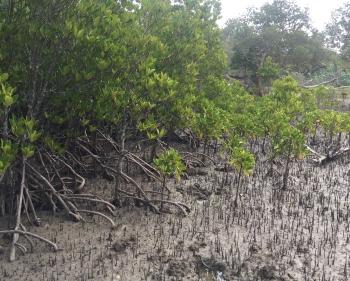
Description
Description
A small to medium-sized tree, 2–5 m, even up to 10 m tall, with strong apical dominance. Stem up to 400 mm in diameter, straight, with distinctive aerial roots or what is also referred to as knee-roots (breathing roots), with rough reddish, brown to almost black bark and extending, bristled, light grey branches.

Leaves compact, simple, oppositely arranged, broadly elliptic to oblong-elliptic, leathery, hairless, glossy, dark green to yellowish green, crowded towards the end of branches; margins smooth with pointed apex and distinctive hair-like tip of up to 5 mm long; tapering at both ends; main vein prominent and with distinguishing black dots underneath the leaves.
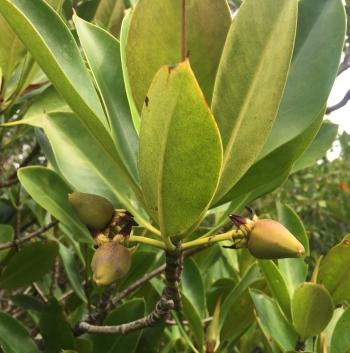
Creamy white flowers, few arranged in axillary heads, leathery with short thick stalks; calyx persistent. The fruit is single seeded, up to 70 mm long, which germinates while still on the tree (viviparous). It is said that its seeds do not last long in storage.

Rhizophora mucronata is a slow grower; it can set one leaf per growing season.
Conservation Status
Status
This species has been Red Listed as Least Concern (LC). Although it is declining due to harvesting and habitat degradation, it is not threatened with extinction, but should be monitored.
This tree is a protected tree in terms of the South African National Forest Act, Section 15(1) of the National Forests Act, 1998. ‘No person may cut, disturb, damage or destroy any protected tree or possess, collect, remove, transport, export, purchase, sell, donate or in any other manner acquire or dispose of any protected tree or any forest product derived from a protected tree, except under a license or exemption granted by the Minister to an applicant and subject to such period and conditions as may be stipulated’. ‘Contravention of this declaration is regarded as a first category offence that may result in a person who is found guilty of being sentenced to a fine or imprisonment for a period up to three years, or to both a fine and imprisonment’.
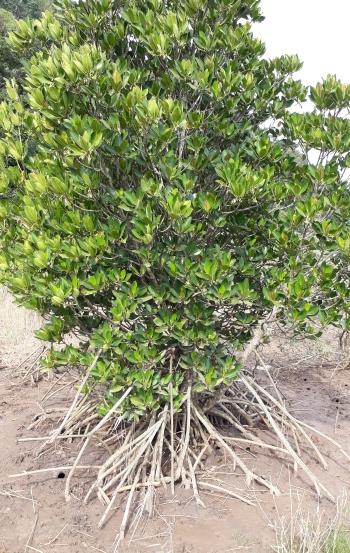
Distribution and habitat
Distribution description
Rhizophora mucronata is encountered in frost-free, summer rainfall regions in mangrove forest swamps, along the coast line of Eastern Cape, from Nahoon, the Mngazana Estuary, with few populations at Port St Johns on the Umzimvubu River, few populations at the eMzimpunzi River Mouth in Mbotyi, to the KwaZulu-Natal coast line, to Kosi Bay in the north. The red mangrove is widely distributed in tropical and subtropical Africa, Asia and America.
Derivation of name and historical aspects
History
Rhizophora is derived from a Greek word rhiza, meaning ‘root’ and phora, meaning ‘to bear’, thus meaning 'bearing roots', referring to the rooting system with roots above the soil. The specific epithet mucronata, is derived from Latin, meaning ‘pointed’, referring to the pointed apex with the hair-like tip. Red mangrove and black mangrove are closely related and can be mistaken when not in flower or without fruit; the most distinguishable aspects apart from the flowers and fruits, are the small dots underneath the leaves and the hair-like point on the apex found in the red mangrove.
Rhizophoraceae has about 16 genera and 149 species worldwide in tropical and subtropical Africa, Asia and America, of which 4 of the genera occur in South Africa, with 10 species. Rhizophora occurs naturally together with Bruguiera gymnorrhiza, Avicennia marina and Ceriops tagal in KwaZulu-Natal, in mangrove forests.
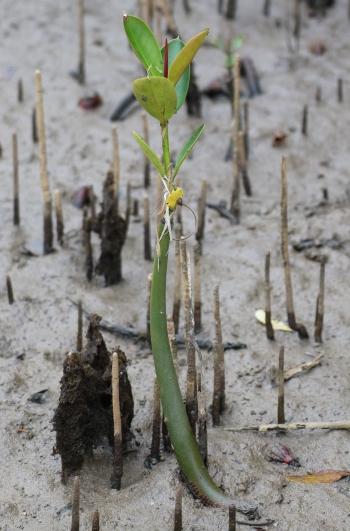
Ecology
Ecology
The red mangrove is said to be pollinated by bees. The viviparous fruit develops an emerging hypocotyl while still on the tree, forming a long tube with a heavy end pointed at the ground. When the fruit has matured, the seed drops and sticks in the mud and so germination takes place. If not, the seed is carried away by the tides, and then at low tide, the seed is inserted in the mud further away from the mother plant, to germinate.
The interesting ecological factor of the mangrove, is how they interact with the root crabs (Goniopsis spp.). The red mangrove does not thrive in anaerobic mud banks, but does well in aerobic mud. The red mangrove often drops older leaves on to the ground where the crabs grab them for food. Therefore, the crabs indirectly aerate the mud, by opening small holes for shelter under the tree. These crabs also benefit the trees by removing dead organic material under the trees, such as dead roots.
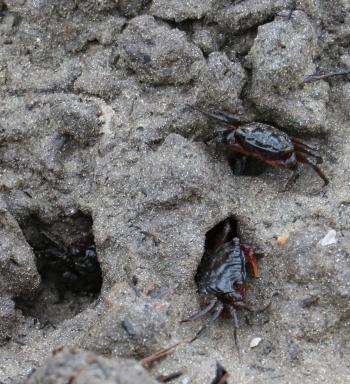
Uses
Use
In South Africa, red mangrove has long been widely used for many things, such as construction of huts in the eastern Cape and KwaZulu-Natal and also for fish traps. The bark is rich in tannin with a dark brown colour, which is used to dye leather. Mangrove wood is known to be very hard, with a high density and no water permeability and resistant to borer infestation. Therefore, the attractive, very heavy wood makes it useful as timber for boats, houses, fences and also fire wood. However, in terms of the law, a permit must be obtained before plants or plant parts are collected. In the Mngazana Estuary in the Eastern Cape, I have come across few tree stumps within the forest, showing that these mangrove trees have been harvested for use.
Mangrove trees serve very important environmental role in protecting coastline from storms, floods and erosion.
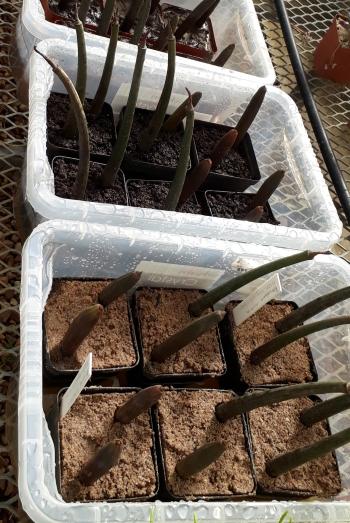
Growing Rhizophora mucronata
Grow
Red mangrove is not yet known to be cultivated anywhere in South Africa, and is not an easy tree to grow in home gardens, but could be a very great feature when grown with precision. Species of mangrove grow naturally in brackish water (fresh water, mixed with sea salty water) in estuaries, swamps and lagoons, but research has shown that these mangroves can also be grown in fresh water.
Red mangrove is best propagated by seeds. When preparing for sowing the seed, one has to have a large container filled with fresh water and pots, about 13 mm deep, sifted bark, river sand or mud and a submersible pump. While potting, add a layer of sifted fine bark at the bottom of the pot to allow water to be absorbed and to prevent the medium from escaping from the bottom of the pot. Then add the river sand or mud. Pour fresh water into the container and fill the pots with river sand or mud, place the pots in the water and insert the seeds by sticking them in the medium (river sand or mud). Insert the submersible pump to circulate the water. The seeds should start germinating in 6 weeks. Once the roots have formed and the seedling has 2 leaf sets, transplant into 35 cm deep pots and leave it soaked in water permanently.
When one is planting the red mangrove in the garden, one should ideally have a flow of water with the trees growing in pots. Allow space in the pot for the tree to expand, as the roots can be very large in confined spaces. Red mangroves are slow growing with at least one leaf set per growing season. Throughout the whole process of growing this tree, use an organic liquid fertilizer, preferably in flowing water. On the water-logged sealed container, there is usually a bacterial and algae bloom, which negatively affects the health of your plants. There are no known pests in cultivation since we are only now trying to cultivate this tree.
References
- Coates Palgrave, K. 2002. Trees of southern Africa. Struik, Cape Town.
- Biodiversity explorer. http://www.biodiversityexplorer.org/plants/rhizophoraceae/index.htm. Accessed 15/11/2017.
- Koekemoer, M., Steyn, H.M. & Bester, S.P. 2015. Guide to Plant Families of southern Africa. Strelitzia 31. 2nd ed., 2nd print. South African National Biodiversity Institute, Pretoria, South Africa.
- Plants of southern Africa: an online checklist. http://posa.sanbi.org. Accessed 08 /11/ 2017.
- Pooley, E. 1993. The complete field guide to trees of Natal, Zululand and Transkei. Natal Flora Publication Trust, Durban.
- Rajkaran, A., Adams, J. & van der Colff, D. 2016. Rhizophora mucronata Lam. National Assessment: Red List of South African Plants version 2017.1. Accessed on 2017/12/07
- The South African National Department of Agriculture, Forestry and Fisheries website, http://www.daff.gov.za/daffweb3/Branches/Forestry-Natural-Resources-Management/Forestry-Regulation-Oversight/Sustainable-Forestry/Protected-Trees. Accessed 08/11/2017.
Credits
Mpendulo Gabayi
Kirstenbosch National Botanical Garden
December 2017
Plant Attributes:
Plant Type: Aquatic, Tree
SA Distribution: Eastern Cape, KwaZulu-Natal
Soil type: Sandy, Clay, Brack/saline
Flowering season:
PH:
Flower colour: White, Cream
Aspect: Full Sun
Gardening skill: Challenging
Special Features:
Horticultural zones







Rate this article
Article well written and informative
Rate this plant
Is this an interesting plant?
Login to add your Comment
Back to topNot registered yet? Click here to register.